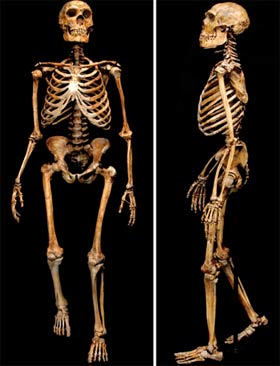Neandertal Advance: First Fully Jointed Skeleton Built
Neandertal Advance: First Fully Jointed Skeleton Built
From: http://news.nationalgeographic.com/news/2005/03/0310_050310_neandertal.html
Stefan Lovgren
for National Geographic News
March 10, 2005
 Scientists have for the first time constructed a fully articulated, or jointed, Neandertal skeleton using castings from real Neandertal bones.
Scientists have for the first time constructed a fully articulated, or jointed, Neandertal skeleton using castings from real Neandertal bones.
The reconstruction, which has been part of several exhibitions, presents a striking visual image of what the Neandertal (often spelled Neanderthal) looked like, experts say.
"At last I felt that somehow I had actually met a Neandertal," said Ian Tattersall, the curator of the Department of Anthropology at the American Museum of Natural History (AMNH) in New York City.
The skeleton was reconstructed by G.J. Sawyer, an anthropologist at the AMNH, and Blaine Maley, a graduate student in the Department of Anthropology at Washington University in St. Louis, Missouri.
Anthropologists have long debated the skeletal differences between Neandertals and modern humans. The reconstruction suggests some strong differences in the form of the Neandertal's rib cage and pelvis compared to those of modern humans.
The research is reported this week in the science journal The Anatomical Record.
Disappearance
Neandertals lived in Europe and some parts of Asia from 300,000 years ago. The last of them mysteriously disappeared in present-day Spain and Portugal 28,000 years ago. Modern humans, many scientists believe, arose in Africa less than 200,000 years ago and appeared in great numbers in Europe starting about 40,000 years ago.
The relationship between Neandertals and the early modern humans, commonly known as Cro-Magnon beings, is fuzzy. The two groups overlapped in Europe for 10,000 years.
The reconstruction could provide scientists with a more complete picture of the stature differences between modern humans and Neandertals.
"It gives the public and scientific community a more grounded basis for comparing this archaic group of Homo to modern humans," said Maley, one of the two authors. "The emotional responses to these differences are much more pronounced than when looking at an artist's conception or comparing individual bones."
The reconstruction was based on a skeleton called La Ferrassie 1, which was discovered in France in 1909. It is a well-preserved and fairly complete fossil skeleton, though missing a complete rib cage, vertebral column, and pelvis. For the reconstruction, the researchers had to obtain these parts from other individual skeletons.
"Before we began, we wondered why it hadn't been done before. But as we ran into many of the complications involved in reconstructing specific bones using two, sometimes three distinct individuals, we realized just how challenging a reconstruction of this magnitude can be," Maley said.
Physically Powerful
When scientists first began to study Neandertal skeletal biology some 100 years ago, they described the Neandertals as slouched, bent-kneed bipeds with primitive mental capacity.
Later studies showed that much of the morphology, or form and structure, of the Neandertals was similar to that of modern humans.
The reconstructed skeleton is 5.4 feet (164 centimeters) tall. The height, though, might have been slightly underestimated, due partly to the use of bone casts from a potentially shorter individual.
"The reconstruction effectively conveys the ruggedness of the Neandertal skeleton and reminds us how physically powerful they must have been," said Wesley Niewoehner, an anthropologist at California State University in San Bernardino.
While researchers in the past have hypothesized that the Neandertal's rib cage was barrel-shaped, the reconstruction suggests more of a conical, bell-shaped trunk.
Fred Smith, the chair of the Department of Anthropology at Loyola University in Chicago, Illinois, said the reconstruction "provides a thought-provoking picture of a Neandertal skeleton [that] is very real and exciting."
But he cautions against drawing any conclusions about the Neandertals' stature and rib cage based on just this skeleton.
"[These] characters … may be as much an artifact of the composite reconstruction as biological reality," he said.
"In any event, even if the stature is correct, it is just one individual and really should not be used to alter our picture of Neandertal stature."
The reconstructed skeleton is currently on display at the Dolan DNA Learning Center in Cold Spring Harbor, New York. It will eventually go on permanent display at the American Museum of Natural History in New York City.


